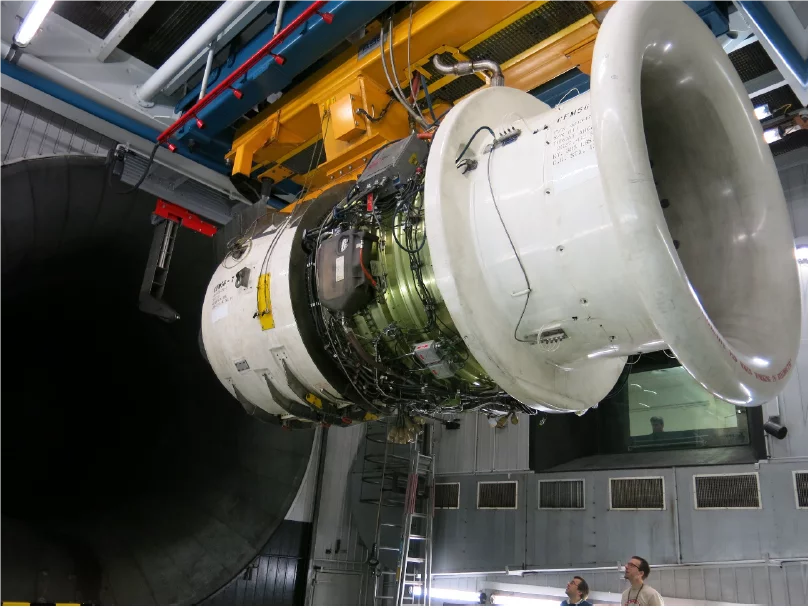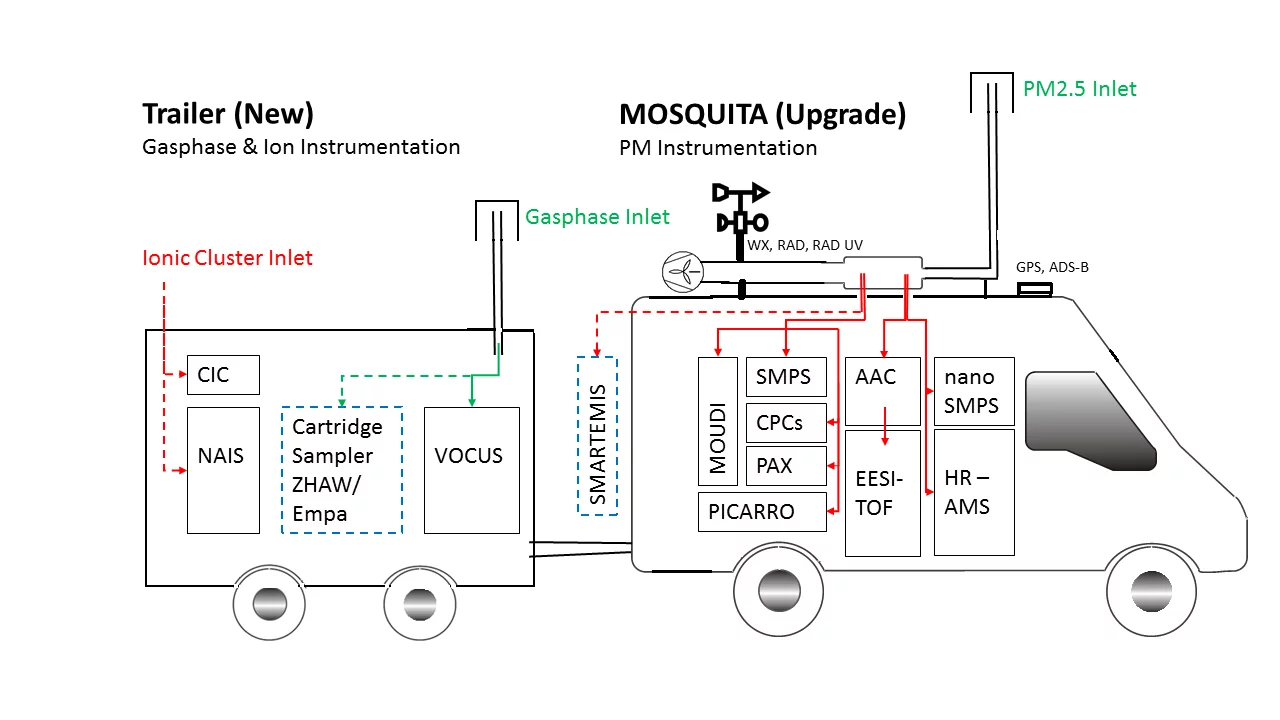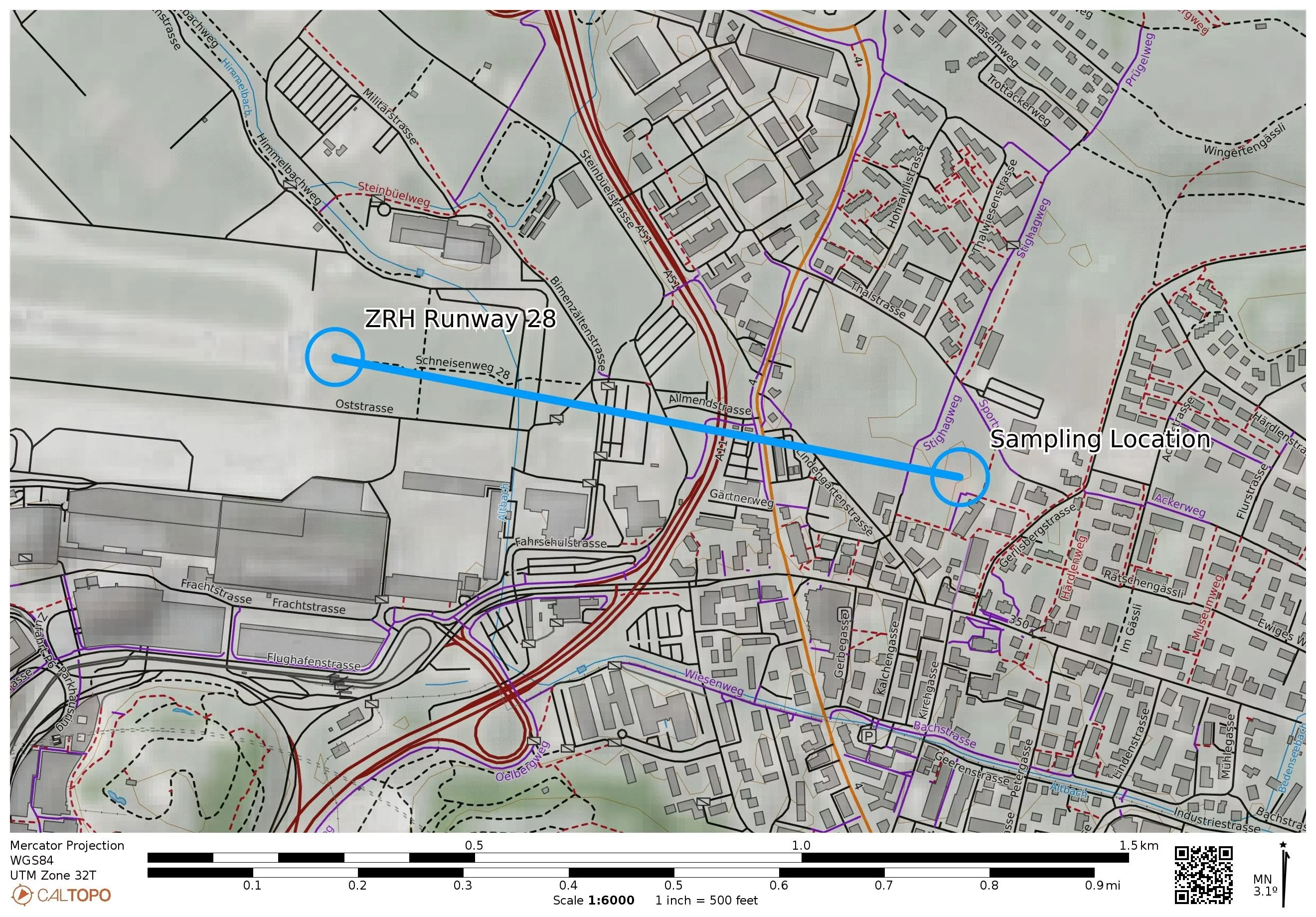Aviation Plume PROPeRtIes AT point of Exposure (APPROPRIATE)
Duration: 2021-2025
Funding: Swiss Federal Office of Civil Aviation (FOCA)
Partners: PSI Laboratory of Environmental Chemistry, ZHAW Centre for Aviation, Empa
Team Members: Sarah Tinorua, Suneeti Mishra, Benjamin Brem, Jay Slowik
Contact: Benjamin Brem (benjamin.brem@psi.ch), Jay Slowik (jay.slowik@psi.ch)
Alumni: Zachary Decker, Peter A. Alpert, Rossella Acampora
The Problem / Scope of the Project
Particulate matter (PM) is a pollutant that has major implications for our health, welfare and the global climate. One can often see particulate matter, such as dust or smoke in the air. However, Ultra Fine Particles (UFP), a subset of PM, are harder to see because they are about 100 times smaller than a human hair, or the size of a coil of DNA.
High concentrations of ultrafine particles (UFPs) are consistently detected near airports. This may be a problem for human health because the toxicity of UFP is greater than typical PM due to their small size and ability to penetrate the alveolar regions of the human respiratory system.
Yet, the source of UFPs near airports is not clear. Airports emit UFPs, but the emissions are complex mixtures of aircraft engine exhaust, vehicle exhaust, and other emissions such as tire rubber. Some emissions begin as particles, but others as gas-phase molecules that grow into particles. We want to untangle these emissions and learn how the emissions transform into UFPs.
The Goals of APPROPRIATE
- Find chemical indicator(s) for emissions originating at airports that distinguish airport emissions from surrounding urban emissions
- Identify fingerprints for the fresh gas-phase and particle-phase emissions associated with specific aircraft engine states (i.e. take-off, idle, etc.).
- Determine the contribution of solid PM (non-volatile, or nvPM) to the UFPs observed near the airport.
- Assess the chemistry and physical changes that occur to the particle composition and shape.
Our partners
Both the ZHAW Centre for Aviation and Empa are scientific partners.
The ZHAW Centre for Aviation includes a State-of-the-are aircraft engine emissions measurement system named The Swiss Mobile Aircraft Emission Measurement System (SMARTEMIS). Currently, SMARTEMIS is located at the SR Technics engine test cell where aircraft engine exhaust is sampled in a controlled setting. We will bring instrumentation from PSI to measure alongside SMARTEMIS.
The laboratory of Advanced Analytical Technologies at the Swiss Federal Laboratories for Materials Science and Technology (Empa will provide analysis of oxidized volatile organic compound (OVOC) cartridge samples. While these measurements do not have a high time resolution they allow the quantification of other important compounds such as e.g. formaldehyde which cannot be detected with the PSI equipment.
Our Strategy
Laboratory
Aircraft engine oils and fuel are expected to be a large source of emissions in both the gas-phase and particle phase. Laboratory studies of both oils and fuel provide us with a chemical fingerprint that we can use to identify the source of emissions we see in the field.
To study the jet engine lubrication oil (Mobile Jet II, purchased from SR Technics) we nebulize the oil into aerosol droplets using a constant output atomizer in our aerosol laboratory. We then sample the aerosol with HR-ToF-AMS and the EESI-TOF aerosol mass spectrometers (see instruments below).
Aerosol are not the only expected emissions. Oil vapors are also likely to be present in aircraft plumes. We use a VOCUS PTR-MS (see instruments below) to obtain lubrication oil vapour chemical fingerprints as well. We are also interested in understanding how these oil vapours may degrade when heated because, for example, in the popular aircraft CFM-56 engine variants the lubrication oil vents through the engine center body into the hot engine core flow. In other words, the oil vapors can reach temperatures of 700 °C. Therefore, we heat the oil vapors to measure thermal degradation products and sample with the VOCUS PTR-MS.
Laboratory measurements also include analysis of particle samples collected in the field using Scanning Transmission X-ray Microscopy (STXM) coupled with Near-Edge X-ray Absorption Fine Structure (NEXAFS) at the synchrotron light source (Swiss Light Source, SLS) located at the Paul Scherrer Institute. Carbon spectra of soot (red in the figure below) organic matter (green) emitted from an aircraft engine, and spectra of mixed organic-iron particles (blue) shown below, demonstrate that different types of matter have distinctive peaks in X-ray absorption allowing for clear identification.
SR Technics Engine Test Cell
The ZHAW Centre for Aviation can directly measure emissions of in-service turbofans in the engine test cell at SR Technics. The unique advantage of the facility is the direct link between emissions and engine operating parameters. In combination with the laboratory samples, these samples will provide a baseline spectroscopic fingerprint to be directly compared with the particles collected at the field location.
Field
Measurements near the Zürich airport will evaluate the real-world performance of the fingerprint candidates for aviation emissions identified in the laboratory and at the engine test cell. Periods influenced by aircraft plumes are identified via air traffic information, meteorological parameters and UFP concentrations. We have two general analytical approaches.
- Identify tracers, such as molecules, that are characteristic of aircraft plumes but at comparatively low concentration from other sources such as vehicle traffic.
- A quantitative mathematical separation of local/regional sources and aircraft sources using a technique named positive matrix factorization (PMF).
Field measurements are facilitated by MOSQUITA, or the “Measurements Of Spatial Quantitative Imissions of Trace gases and Aerosols". The MOSQUITA is a mobile laboratory vehicle and is currently undergoing significant upgrades, including the attachment of a trailer. To tackle the proposed objectives we intend to install and integrate a wide range of aerosol and gas phase instrumentation, listed below, into the MOSQUITA.
|
PM Properties |
|||
|
Variable(s) |
Instrument/ Manufacturer |
Time Resolution (s) |
Comment |
|
PM2.5 composition |
HR-ToF-AMS, Aerodyne Research Inc. |
1 |
Fragmented, size resolved chemical composition of OC and inorganics |
|
UFP composition |
EESI-TOF, TOFWERK- PSI |
5 |
Molecular composition of OC, inorganics and soluble metals |
|
Size selector for EESI TOF ( > 20 nm – 1 μm) |
AAC, Cambustion Inc., |
not applicable |
Upstream of EESI TOF as size selector |
|
Black carbon content |
PAX-870, Droplet Measurement Technologies (DMT) Inc. |
1 |
eBC via absorption coefficient |
|
PM Material for offline characterization |
MOUDI 125R, TSI Inc. |
Integrated Sampling |
For offline STXM characterization |
|
PM Material for offline characterization |
PARTECTOR TEM, naneos GmbH |
Integrated Sampling |
For offline TEM characterization |
|
PM size distribution |
Standard SMPS 3938, TSI Inc. |
≥ 20 |
Fast scan |
|
PM size distribution |
Nano SMPS 3938E57, TSI Inc. |
≥ 20 |
Fast Scan |
|
Total PM number |
CPC 3756, TSI Inc. |
0.1 |
with switchable thermo denuder upstream |
|
Total PM number |
CPC 3750, TSI Inc. |
0.1 |
with switchable thermo denuder upstream |
|
Ion distribution (0.8 - 40 nm size equivalent) |
NAIS, Airel Inc. |
60 |
Measures also ultrafine PM size distribution |
|
Total concentration of cluster ions |
Cluster Ion Counter, Airel Inc. |
1 |
Complementary to NAIS, low losses |
|
Gas Phase and Ancillary |
|||
|
Variable(s) |
Instrument/ Manufacturer |
Time Resolution (s) |
Comment |
|
Gaseous VOC composition |
VOCUS PTR-TOF, Tofwerk AG |
5 |
Ultra high resolution and low sensitivity and wide range of species |
|
CO, CO2, CH4, and H2O |
G2401, Picarro Inc. |
1 |
Most abundant exhaust gases |
|
Meteo |
WS510 UMB, Lufft Inc. |
10s |
Temperature, Relative Humidity, Barometric Pressure, Total Radiation, Wind speed/ direction |
|
UV Radiation |
CUV 5, Kipp & Zonen Inc. |
10s |
UV spectral range 280 to 400 nm |
|
Air Traffic |
ADS-B Receiver, GNS 5890 |
NA |
Recording of all ADS-B signals which can be received on the ground at the specific location |
Our field deployment will occur at the Ostluft Station Kloten Field to sample emissions from the Zürich airport. This location is an ideal location for many reasons.
- The Ostluft Station Kloten Feld operated by the Amt für Abfall, Wasser, Energie und Luft (AWEL) of Canton Zürich is within 1 km of aircraft runways and slightly (15 m) elevated above the busy runway 28 of Zürich airport. At this distance, individual plumes have risen and are entering the well mixed dispersion regime
- It is downwind of the airport (dominant airport wind direction is west especially in winter).
- It is representative of a typical receptor location in the Zürich Airport area where children are going to school and people are living.
Two main field deployments (one in the summer and one in the winter) will occur. These two deployments will aim to:
- Determine the gas-phase molecules (VOCs) that form secondary organic aerosol (SOA). The role of aircraft VOC emissions in local and regional air quality, SOA formation, and UFP formation and growth are not well understood. This is due in part to the operational challenges in measuring real-world aircraft emissions with sufficient temporal resolution and chemical coverage. We address these issues by the deployment of a newly developed instrument for the measurement of primary and oxygenated VOCs, the VOCUS PTR-MS. Capable of fast, quantitative measurements across nearly the full range of VOCs relevant for public health and climate, the proposed VOCUS PTR-MS measurements represent a significant step forward in understanding the environmental and societal impacts of aircraft VOCs.
- Determine the size-resolved chemical makeup of aircraft plume PM. Previous measurements of particle composition in aircraft plumes have been limited in terms of chemical resolution and their ability to determine the UFP fraction. These limitations hinder interrogation of aircraft PM chemical evolution during real-world operation, especially in regards to the strongly climate- and health-relevant UFP fraction. We address these issues via the first deployment of size-resolved EESI-TOF measurements for the characterization of UFP organic, inorganic, and metallic composition.
- Assess the contribution of lubrication oil in aircraft emissions. Lubrication oil is hypothesized to be a significant contributor to primary aircraft emissions under some operating conditions. Our laboratory and test cell experiments can establish a direct link between aircraft emission and specific in-engine processes, facilitating the development of efficient engine operation and construction guidelines. Further, fingerprints found in the laboratory and test-cell experiments will constrain the lubrication oil chemical profile when performing a PMF analysis, yielding a robust separation from other aircraft emissions and background aerosol.
- Assess the contribution of non-volatile PM on UFPs. There are many reasons to expect the semi-volatile composition of each particle mode (Aitken nvPM, nucleation, accumulation) to be different. However, combining SMARTEMIS with MOSQUITA will provide the most comprehensive and size-resolved chemical characterization covering the range from nucleation through Aitken to accumulation modes of aircraft ground emission PM under real-word conditions.
- Assess effects of known and hypothesized plume processing pathways on PM mass, composition, and morphology. Particle filters containing aircraft particle emissions in the field will be analyzed using STXM/NEXAFS and the Swiss Light Source at PSI.





